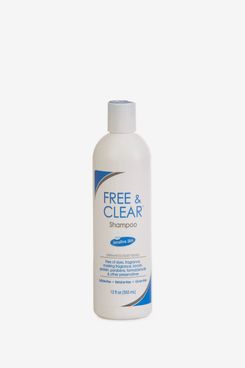
Over the last few years, I’ve learned that I’m allergic to a lot of things, many of which are ingredients in fancy beauty products. I’d spent years cycling through increasingly expensive serums and cleansers to solve an amorphous, shifting cloud of hair and skin problems — flaky scalp, red skin, dryness, breakouts — that ended up dissipating once I realized that the problem was contact dermatitis, not that I wasn’t exfoliating hard enough. My skin felt a million times better after switching from La Roche-Posay cleanser to a cheaper, fragrance-free micellar water, for example, and after I traded Dr. Dennis Gross peels for plain old Cetaphil face soap. The difference I felt most dramatically was swapping out a hair routine that involved Olaplex No. 3 and a $42 Briogeo charcoal scalp scrub (bought in desperation to heal my scalp) for a highly clinical, unglamorous shampoo: Vanicream, formerly known as Free & Clear.
A lot of products marketed for sensitive skin contain essential oils and botanical ingredients, which feel intuitively more wholesome — it sounds right that bathing your hair in goat’s milk and wild oats would be restorative — but if you’re in the minority of people who are allergic to those natural ingredients, they’re not so benign. Each time I had a reaction to something, a puzzle piece clicked into place — it explained why other products never worked quite right, but also eliminated a swath of my skin-care shelf. After the aloe gel I used with my NuFace device turned my face lobster red, for example, I stopped using Seaweed Bath Co.’s unscented shampoo and conditioner, Olaplex No. 3, and Manic Panic hair dye (all of which contain aloe). A bottle of lavender soap made my hands dry and skin crack like it was the dead of winter, which eliminated the lavender-containing Fur oil I’d comb into my scalp to moisturize dry hair. At first, I tried to track down which ingredients seemed to be irritants, but the next time a product with a dozen extracts led to a breakout, it added another set of variables, until I faced infinite branching paths, like the protagonist of a postmodern Borges story tasked with keeping a skin-care diary.
The benefit of Vanicream’s hair products is that they eliminate this need for conspiracy-boarding, potentially irritating ingredients because the brand has already done it for you. The label, which looks like it was designed in Microsoft Word and is attached to the bottle with a glue that causes it to wrinkle and buckle after getting wet, reads like it was written from the other side of the allergen-elimination process: The shampoo is “free of dyes, fragrance, masking fragrance, lanolin, protein, parabens, and formaldehyde releasers” as well as sulfates, gluten, and betaine, most of which I hadn’t yet learned to avoid.
The first time I used the shampoo, I was incredulous that I didn’t feel any stinging or itchiness, which I had thought was normal aftereffect of cleaning your hair. “Does your scalp always hurt after you take a shower a little bit?” I texted my sister, who also is on a hair journey that has not yet reached its conclusion, and told her about the shampoo. “My scalp never hurts after a shower,” she politely informed me. “But that is good news!”
Since buying the shampoo, my hair routine has gotten easier and cheaper, and reliably produces boy-band-floppy hair days. I’ve also bought the brand’s conditioner, which I like, although it can leave my hair dry and fluffy, which I don’t. Still, switching to Vanicream has eliminated most of the scalp-stinging and flakes (during extra-dry stretches, I’ll skip shampoo for an apple cider vinegar solution in a squeeze bottle). After a few months, my hair was healthy enough to bleach blonde, and I’ve stuck with Vanicream since then instead of switching to color-specific products with longer ingredient lists — instead of buying a purple conditioner, for example, which helps prevent blonde hair from turning brassy, I mixed Pravana semipermanent dye into my Vanicream conditioner, with pretty good results. (The Pravana dye contains lanolin and fragrance, but I’ve still found the home brew is better for my scalp than other purple conditioners.)
I’m not the only fan of Vanicream: The brand makes a face cleanser dermatologists recommend using with acne medication Accutane, which dries skin and requires cutting out harsh or irritating ingredients from your routine. Its one-pound tub of moisturizer is also popular — Strategist writer Lauren Ro bought it while eliminating certain chemicals from her skin-care routine and named it her favorite purchase of 2021. (She wrote that she was “immediately impressed with how luxurious and rich the cream felt on my skin.”) Although the Vanicream shampoo may not have as many bells and whistles as my luxury scalp scrubs, I’ve realized that sometimes the boring thing is exactly what you need — a conclusion that’s easier to swallow when it costs $11.
Some other hair products for sensitive skin we’ve written about
The Strategist is designed to surface the most useful, expert recommendations for things to buy across the vast e-commerce landscape. Some of our latest conquests include the best acne treatments, rolling luggage, pillows for side sleepers, natural anxiety remedies, and bath towels. We update links when possible, but note that deals can expire and all prices are subject to change.












